Climate Illuminated

Climate History


The first question one might ask is what is the value of going back so far in time and how is doing that relevant to conditions today?
The answer is that there is immense value in looking at history, and in particular, Earth’s history provides some very pertinent data that completely refute very distorted and unsubstantiated claims by the AGW alarmists of today.
Let us take a look over geologic time and see what history tells us. Below is a graph showing estimates of Earth’s Temperature in blue and atmospheric CO2 in black, plotted over time, from about 600 million years ago to the present. Several significant, pertinent observations stand out immediately.
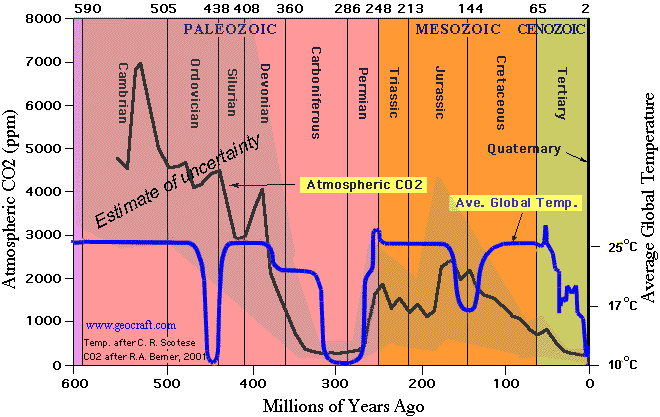
1. First of all, during the Cambrian Period, CO2 reached 7,000 ppm, though Ian Plimer in “Heaven and Earth” says 8,000 ppm. That is about 20 times the present level of 400 ppm. Today one hears that we are at the “tipping point”, the “point of no return”, and that further increase in CO2 will destroy life on Earth! What happened historically at this very “lofty” level? Life exploded with a more rapid evolution and differentiation of species than had ever occurred before or since! There was no thermal runaway; oceans did not boil away. CO2 at this level was exceedingly beneficial to life.
2. A second point to note is that there is no correlation of Temperature with CO2. It is not possible, based on this data, that CO2 could be driving Temperature. History thus destroys any validity of CO2-based global warming theory.
3. A third point to note, and extremely crucial to be aware of, is that today we are at an historic low in atmospheric CO2, and as will be shown, this is an extremely dangerous condition, that threatens the continued existence of life! At 400 ppm CO2 in the atmosphere, the Earth is starved for CO2. Many people would be very surprised to hear that the CO2 danger is with its being too low, rather than too high, the complete opposite of what people have been led to believe! If CO2 were to drop another 2 ½ times, photosynthesis begins to shut down. Don’t take our word for it: Below is an image of rice plants grown in an atmosphere with different levels of CO2. If CO2 were to drop much below 200 ppm, it is clear that growth becomes stunted. CO2 is not a pollutant, but absolutely essential to life.
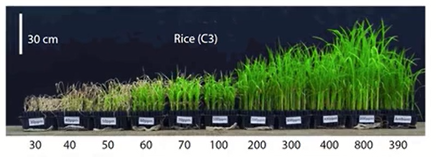
Another very intriguing observation is that the level of CO2 in the atmosphere has dropped dramatically over geologic time, raising the question of what happened to all of the CO2? A very surprising fact is that 95% of Carbon in Earth’s Lithosphere/Biosphere is contained in Limestone and other carbonaceous rocks, largely as CaCO3. These are formed from sediments of marine life, as CO2 is consumed in the formation of CaCO3. So the conclusion is that atmospheric CO2 has decreased due to life consuming CO2 from the oceans (which contain vastly more CO2 than the atmosphere) and sequestering it in Limestone! This is a one-way trip to extinction, if CO2 is not somehow replenished! (Fortunately it is as a result of volcanism.)
So there is an extensive amount of valuable, and surprising information derived from looking at Earth’s climate history on this very long time-scale.
Shortening the time scale 1000 times, and looking more recently, consider the Vostok Ice Core Data from Antarctica, which has given data on Temperature and CO2 over the last 420,000 years; Temperature is shown in blue, CO2 in red.
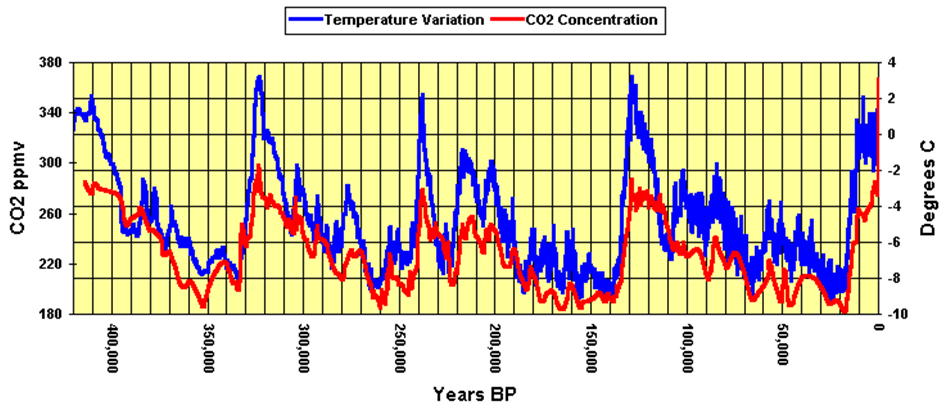
The first thing to note is that CO2 lags Temperature, and therefore cannot possibly be driving Temperature, another point that absolutely invalidates CO2-based global warming theory. Many scientists say that the lag is about 800 years, but a rigorous cross-functional statistical analysis (sliding the CO2 data back and forth relative to the Temperature data, looking for the highest degree of correlation) by Dr. Jeffry Glassman (Link) gives 1073 years as the delay. The lag is believed to be related to the time constant for ocean mixing of deep ocean water with the surface. As the temperature increases, and the oceans warm, CO2 is less soluble in water and it bubbles into the atmosphere increasing its concentration.
Another exceptionally noteworthy observation, and one devastating to CO2-based theory, is that when CO2 is near peak values, the Temperature starts to drop. When CO2 is at minimum values, the Temperature starts to rise. This is completely reversed from what would be expected if CO2 were driving Temperature.
Another significant observation is the rather striking periodicity of the data. This is believed to be related to Milankovitch Cycles, associated with variations in the Earth’s orbit around the Sun and axial tilt, caused primarily by the massive planets, Jupiter and Saturn, giving an approximate periodicity of about 100,000 years. (There are multiple overlapping cycles which result in the periodicity not being exact.)
As a final observation, it would seem that in our very near (geologic time scale) future, we will be experiencing significant cooling which will be much more difficult for humans to cope with than warming.
To proceed further, there needs to be some clarification of terms. In Earth’s history, an Ice Age is defined as a period in time when there is ice at the poles, so we are currently in an Ice Age! There have been 5 Ice Ages in the Earth’s history, but for most of Earth’s history there has been no ice at the poles, about 80% of Earth’s history. This is corroborated by tropical fossils found at or near the poles, so ice at the poles is unusual in Earth’s history. Most of us would not think we were in an Ice Age, and AGW alarmists are constantly warning us of melting ice at the poles being disastrous, but that is Earth’s more normal state!
The current Ice Age is the Pliocene-Quaternary glaciation which started 2.58 million years ago, and it consists of alternating sequences of glacial and interglacial periods, as shown for a portion of that time, by the Vostok Ice Core Data. Thus the Earth is currently in an “interglacial period” (of an Ice Age), fortunately for us!
During the last Glacial Maximum, 18,000+ years ago, sea levels were low (more than 130 meters lower than today – about 400 feet), as were CO2 levels (about 180 ppm, a very low number, stressing life, planet-wide). Ice covered about 32% of land area. Today, only about 10% of land is covered by glacial ice, and most glaciers are younger than about 4,000 years, very young indeed.
The last glacial period ended about 11,000 years ago, with major changes occurring on the Earth since then.
Following the end of the last glacial period, initially sea level rose rapidly as glacial ice melted with increasing temperature. With the dramatic slowing of the temperature rise, the rate of ice melting slowed, along with a significant drop in the rate of sea level rise. Today’s rate of sea level rise is very slow, amounting to around 100 mm in about 60 years, or about 0.065 inches per year, and that rate has been essentially constant since around 1860, well before significant fossil fuel emissions by humans. Moreover, the rate has not increased since 1945 with the onset of increased anthropogenic fuel emissions, another AGW problem!
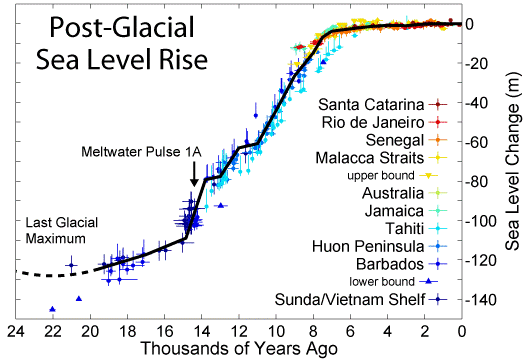
There have been warm and cold periods since the end of the last glacial period, with temperatures significantly exceeding today’s temperature multiple times, and with lower CO2 levels than today, still more problems for AGW alarmists.
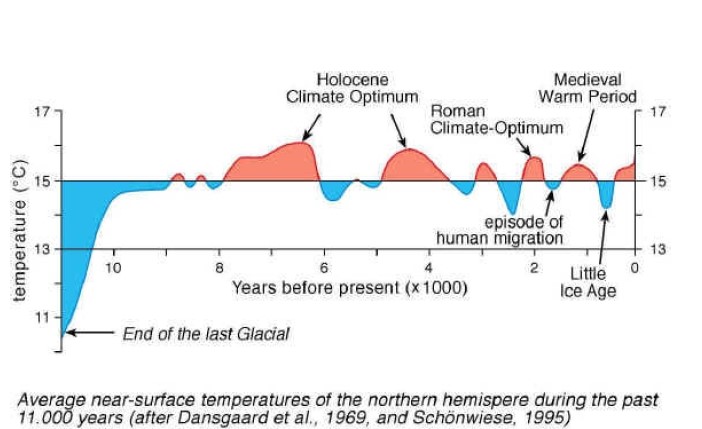
Fairly recently during the Medieval Warm Period from about 900 to 1300 ce (or AD) (roughly coinciding with the Middle Age in Europe) the Vikings settled Greenland, Labrador, and Newfoundland, calling it Vinland as they were able to grow grapes for wine, and they had dairy cattle. It was warmer there 1,000 years ago than it is today, with CO2 at about 100 ppm lower than today. They were frozen out during the Little Ice Age between about 1500 and 1600. It has been warming since, for reasons unrelated to human fossil fuel consumption.
Greenland seems to be a favorite locale for AGW alarmists to push their flawed scenarios. So look closely at some uncontestable data from Greenland. Below is data taken at 4 weather stations in Greenland over a 100 year time period from 1900 to 2000. (Weather stations: Upernavik, Ilulissat, Nuuk, Tasiilaq) Data is from a YouTube video of Ivar Gaiever
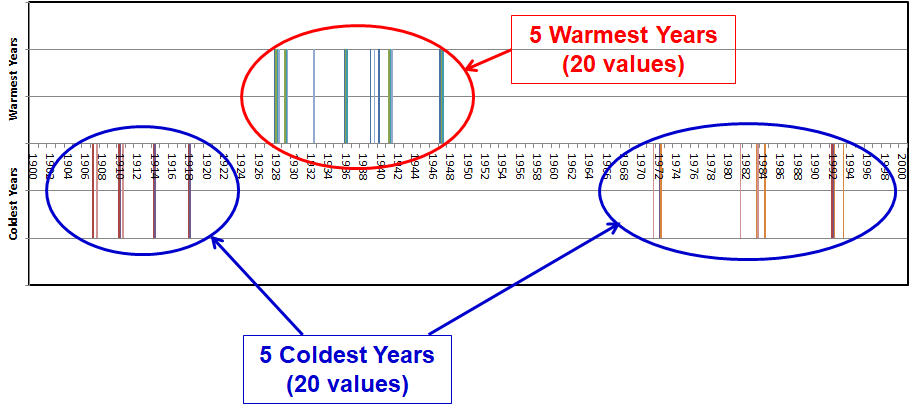
This plot shows the 5 warmest years of annual temperature readings (plus side of the vertical axis) and the 5 coldest annual readings (negative side of the vertical axis) at each of the 4 stations. The warmest years are all in the 1930’s and 1940’s, and the coldest years occurred from 1907 to 1918 and from 1971 to 1983. Clearly it has not been warming at these locations in Greenland in the latter half of the twentieth century, despite higher CO2 levels than during the warmer 1930’s and 1940’s!
Another fascinating Greenland tidbit, uncontestable, is “Glacier Girl”. Near the end of WWII, in 1942, a squadron of P-38’s, were flying from northeastern US, trying to reach England to support the war effort. They ran into a very severe storm, were not able to proceed past Iceland, and had to turn back. Running low on fuel they were forced to crash land on a Greenland glacier, which they were able to accomplish without loss of life. The crews were rescued, but the planes were abandoned. In 1992, 50 years later, the planes were again located, buried under 268 feet of ice!!! One plane was retrieved piece by piece, rebuilt, and is now flying as “Glacier Girl”!

Moreover, very recently, for the years 2014 – 2016, Greenland has been adding ice.
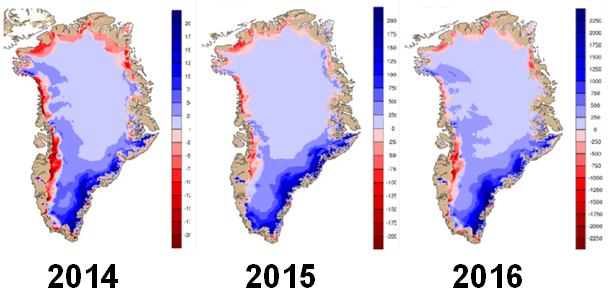
Map of the Accumulated Surface Mass Balance (in mm water equivalent)
One can readily see though, that depending on where one might choose to perform a study of Greenland Ice, one could easily come up with any answer one might want. However, overall Greenland has been adding ice, contrary to many AGW claims.
As a final comment on Earth’s Climate History, there has been no appreciable warming during the now nearly 20 years, referred to as the “Pause” or “Hiatus”, as measured by satellite, despite a significant continued rise in CO2.
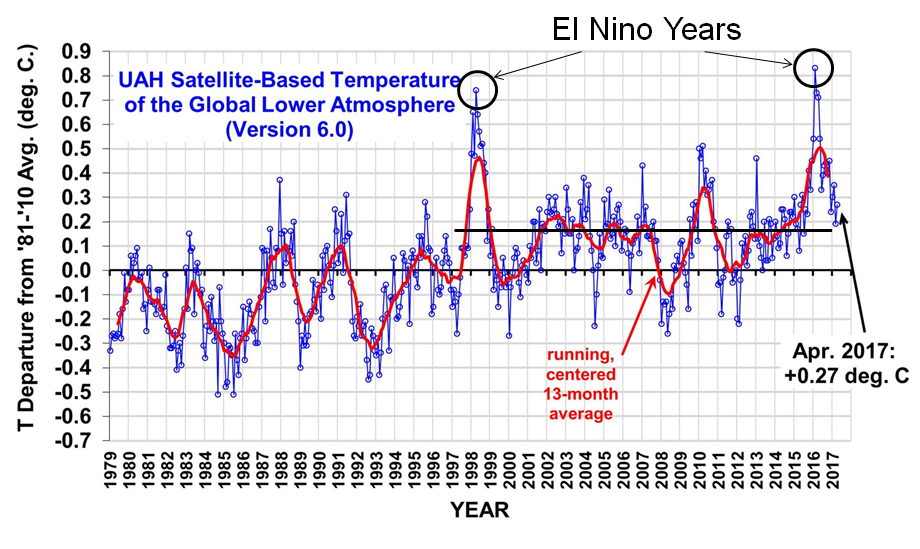
We should revisit occasionally what the proper role of government is. As the constitution was a good sense of direction, we need a core set of principles to add in order to deal with the future.
So many want to engineer society, remove risk, assist certain groups, rather than let individuals thrive and raise communities. Why?
Is Democracy where we all "get it good and hard" or is it the best means to a free society?
Should we roll with the special interests, or make the government achieve its proper role, what is that role, and how to do this?
When do deficits and governments become too large?
Government is becoming more elitist while trying to sell corrections to problems it created, what makes this possible?
This could also be inserted into the field above, or erased
Currently as a society, we are having a most difficult time discussing political issues. What is driving this? And why a rebirth in political culture would be a good thing.
Are "markets" dead as some would conjecture? Or is free enterprise what got us here?
At the heart of economics there are several possible economic schools of thought, the essence of these schools of thought and how they relate to our lives.